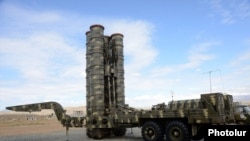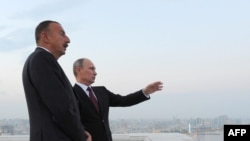Russia will reinforce its joint air-defense system with Armenia within the framework of a Russian-led military alliance of six ex-Soviet states, President Vladimir Putin announced late on Tuesday.
“We are planning to strengthen the integrated air-defense system with Belarus and set about forming similar regional systems with Armenia and Kazakhstan,” Russian news agencies quoted Putin as saying at a meeting in the Kremlin with senior Russian military officers. He said this will foster peace and stability “in the entire Eurasian space.”
The Russian and Armenian militaries have been jointly protecting Armenia’s airspace ever since the late 1990s. Their integrated air-defense system was given a “regional” status by the Collective Security Treaty Organization (CSTO) in 2007. Top Russian military officials said at the time that Moscow has upgraded Armenia’s anti-aircraft capacity and trained Armenian specialists to operate sophisticated S-300 systems, the most potent surface-to-air missiles in Yerevan’s military arsenal.
Sergey Minasian, a senior analyst with the Caucasus Institute, a Yerevan-based think-tank, suggested that Moscow is simply keen to extend the existing system’s geographic span to the entire South Caucasus. “This will allow the Armenian air-defense units to have greater radar coverage,” Minasian told the Regnum news agency.
Russia announced plans last month to modernize 16 or so MiG-29 fighter jets that are part of a Russian military base stationed in Armenia. It is also due to help Armenia expand its small air force integrated into the national air-defense system.
“Not only the air force but also the air-defense system in general will be modernized and re-equipped,” CSTO Secretary General Nikolay Bordyuzha said in June. He linked this assistance with plans for the creation of multinational army contingents operating under the CSTO aegis.
Putin similarly cited on Tuesday the impending “creation of regional groupings of troops involving Armenia, Belarus, Kazakhstan and Tajikistan.” He implied that they will comprise Russia’s joint air-defense systems with fellow CSTO member states.
The Russian leader spoke two weeks before his widely anticipated visit to Armenia. According to Armenian press reports, he will not only hold talks with President Serzh Sarkisian but also visit the Gyumri headquarters of the Russian troops deployed in the South Caucasus state.
The commander of the Russian base, Colonel Andrey Ruzinsky, stated last month that his forces could fight on the Armenian side if Azerbaijan attempts to end the Nagorno-Karabakh conflict by force. The Russian government did not publicly disavow this statement strongly condemned by Baku.
Putin visited Azerbaijan as recently as in August, just two months after it emerged that Moscow has begun supplying the Azerbaijani army with $1 billion worth of tanks and other offensive weapons. The two developments came amid mounting Russian pressure on Armenia over the latter’s plans to sign a far-reaching Association Agreement with the European Union. President Sarkisian scuttled the signing of that agreement when he unexpectedly announced, after September 3 talks with Putin, his decision to make Armenia part of a Russian-led customs union.
“We are planning to strengthen the integrated air-defense system with Belarus and set about forming similar regional systems with Armenia and Kazakhstan,” Russian news agencies quoted Putin as saying at a meeting in the Kremlin with senior Russian military officers. He said this will foster peace and stability “in the entire Eurasian space.”
The Russian and Armenian militaries have been jointly protecting Armenia’s airspace ever since the late 1990s. Their integrated air-defense system was given a “regional” status by the Collective Security Treaty Organization (CSTO) in 2007. Top Russian military officials said at the time that Moscow has upgraded Armenia’s anti-aircraft capacity and trained Armenian specialists to operate sophisticated S-300 systems, the most potent surface-to-air missiles in Yerevan’s military arsenal.
Sergey Minasian, a senior analyst with the Caucasus Institute, a Yerevan-based think-tank, suggested that Moscow is simply keen to extend the existing system’s geographic span to the entire South Caucasus. “This will allow the Armenian air-defense units to have greater radar coverage,” Minasian told the Regnum news agency.
Russia announced plans last month to modernize 16 or so MiG-29 fighter jets that are part of a Russian military base stationed in Armenia. It is also due to help Armenia expand its small air force integrated into the national air-defense system.
“Not only the air force but also the air-defense system in general will be modernized and re-equipped,” CSTO Secretary General Nikolay Bordyuzha said in June. He linked this assistance with plans for the creation of multinational army contingents operating under the CSTO aegis.
Putin similarly cited on Tuesday the impending “creation of regional groupings of troops involving Armenia, Belarus, Kazakhstan and Tajikistan.” He implied that they will comprise Russia’s joint air-defense systems with fellow CSTO member states.
The Russian leader spoke two weeks before his widely anticipated visit to Armenia. According to Armenian press reports, he will not only hold talks with President Serzh Sarkisian but also visit the Gyumri headquarters of the Russian troops deployed in the South Caucasus state.
The commander of the Russian base, Colonel Andrey Ruzinsky, stated last month that his forces could fight on the Armenian side if Azerbaijan attempts to end the Nagorno-Karabakh conflict by force. The Russian government did not publicly disavow this statement strongly condemned by Baku.
Putin visited Azerbaijan as recently as in August, just two months after it emerged that Moscow has begun supplying the Azerbaijani army with $1 billion worth of tanks and other offensive weapons. The two developments came amid mounting Russian pressure on Armenia over the latter’s plans to sign a far-reaching Association Agreement with the European Union. President Sarkisian scuttled the signing of that agreement when he unexpectedly announced, after September 3 talks with Putin, his decision to make Armenia part of a Russian-led customs union.






